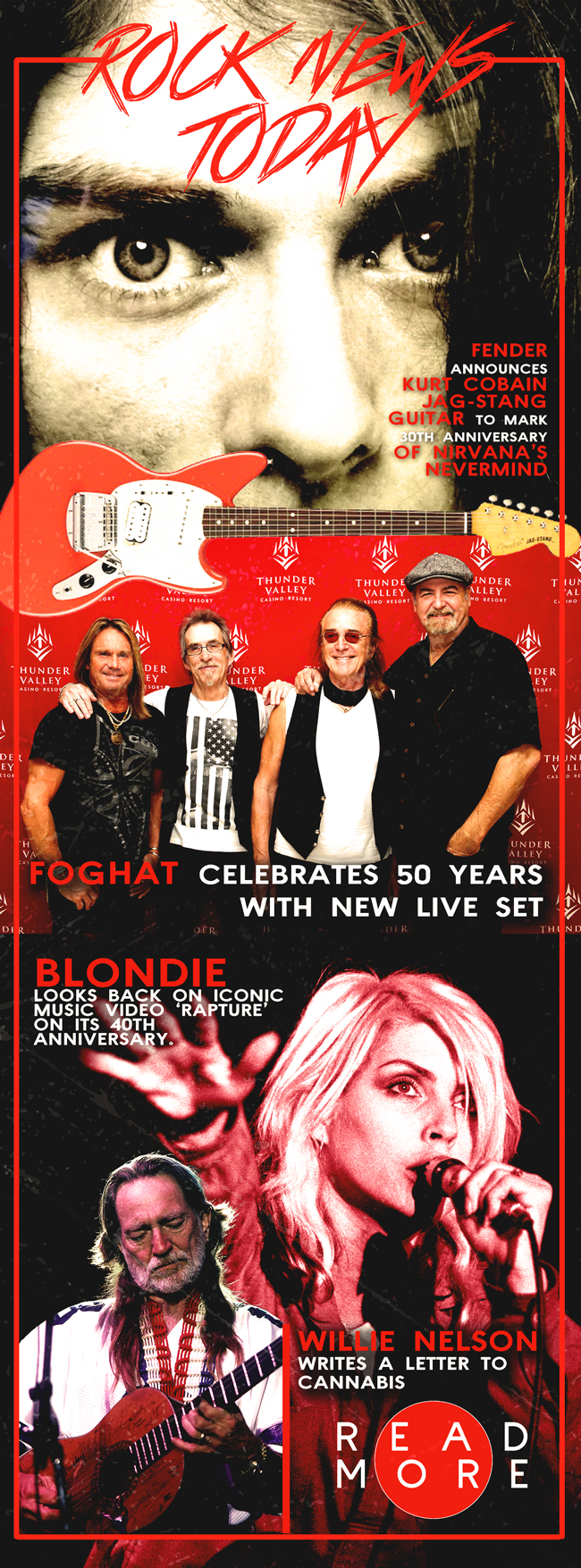



Fender Announces Kurt Cobain Jag-Stang Guitar to Mark 30th Anniversary of Nirvana’s Nevermind

Fender's 2021 lineup also includes a J. Mascis Telecaster and a Primal Scream Stratocaster
Fender is reviving its signature Kurt Cobain Jag-Stang electric guitar to commemorate the 30th anniversary of Nirvana’s seminal album Nevermind. The guitar was originally designed by Cobain for Fender in 1993. It combined the late grunge legend’s favorite aspects of his two go-to instruments: The Jaguar and the Mustang.
Per Cobain’s specs, the Jag-Stang features an alder body, 24” short scale length, 7.25” radius rosewood fingerboard, and vintage-style single-coil and custom humbucking pickups. It will be produced in both sonic blue and fiesta red colors, and left-handed and right-handed models will be available. The guitar’s expected release is October 2021 with a suggested retail price of $1,249.99, and it’s available for pre-order via Reverb.
The Jag-Stang was originally issued in 1995, after Cobain’s passing, before being discontinued in 2001. Due to popular demand, Fender Japan reissued it two years later, but Fender ceased importing the guitar from Japan in May 2006.
The Cobain announcement came as part of a broader Fender press release, unveiling a stacked new line of 2021 Artist Signature Models. In addition to the Cobain Jag-Stang, Fender will release the J. Mascis Telecaster ($1,349.99) in August, recreating one of the Dinosaur Jr. vets favorite axes: the original 1958 top-loader Tele guitar used to write the band’s classic mid-’90s songs. If the 2021 signature model lineup wasn’t bountiful enough for alt-rock loving guitarists, a custom Primal Scream Screamadelica Stratocaster ($1049.99) will arrive in November.
CREDITS: Jon Hadusek - https://consequence.net/
Blondie looks back on iconic music video ‘Rapture’ on its 40th anniversary.

Forty years ago, Debbie Harry went on network TV to introduce a new musical phenomenon called hip-hop. “The most recent fad to catch on with kids in our big cities and metropolitan areas is rapping,” the Blondie singer explained to the audience on the network variety show “Solid Gold,” in 1981.
After mentioning some of the genre’s rising stars from the Bronx — the Sugarhill Gang, Grandmaster Flash, the Funky 4 + 1 — Harry introduced her band’s latest rap-inspired video. “Using our new single, ‘Rapture,’” Harry said, in a professorial tone, “Blondie and some of our friends put together a number to show you what rapping in the street scene is like.”
What followed remains one of the most surprising, delightful, and groundbreaking videos of all time. It has everything: Jean-Michel Basquiat playing a DJ, graffiti artists Lee Quiñones and Fab 5 Freddy, Debbie Harry rapping, voodoo dancers, a goat! The mini-film — directed by Keith Macmillan, a k a “Keef” — was a revelation, in an era when most music videos consisted of a band pretending to perform a song on a soundstage. It not only told a story, it also merged New York City’s hip-hop, art and clubbing cultures in a totally unprecedented way.
When the new cable channel MTV launched later that year, in August 1981, “Rapture” was not only the sole “rap” video it aired on its first day, it was one of the few clips that had any kind of urban grit at all — not to mention one of the few that included people of color. (MTV wouldn’t air a video by a rap group until Run-DMC’s “Rockbox” a whole three years later.)
“One of the things that strikes me about ‘Rapture’ is that it really was the first in many ways,” Harry told The Post. “It’s funny because at the beginning, I didn’t like [the video] so much — I was probably thinking in a more grandiose kind of style, to get the true atmosphere of the Lower East Side where the train yards are and create something truly wild … But now, I like it.” “It is one of the all-time great New York City videos,” said Sean Corcoran, who curated the exhibit “New York New Music: 1980-1986,” currently at the Museum of the City of New York.
“It really encapsulates the kind of cross-pollination and energy that was happening in the city at that time, especially downtown. It shows Blondie — who were already a successful band with hits at this point — taking this new form of New York music and really absorbing it and honoring it.” “Rapture” couldn’t have happened without Fred Brathwaite — a k a Fab 5 Freddy. Brathwaite, an artist, and man-about-town met Blondie guitarist Chris Stein through the public access show “TV Party,” and he took Stein and Harry to their first hip-hop show in the Bronx, in 1979, where they saw a then-21-year-old turntable whiz Grandmaster Flash perform.
“I was playing at a place called Webster Gym, when I saw Freddy coming from the rear with somebody with blond hair,” Flash told The Post. “I just kind of froze.” When Brathwaite introduced them, Harry said, “I’ve been staring at you for the past 20 minutes or so, and I must say, you are quite incredible on those turntables.
I’ve never seen anything like that before,” Flash recalled. Then she said, “You know something? I feel so good about this, I’m going to make a record about you.” Six months later, he heard Harry rapping, “Flash is fast, Flash is cool,” on the radio. “She kept her word!” he whooped. Harry and Stein wanted the video to combine the uptown hip-hop world with the arty downtown scene they frequented. It would feature a house party DJed by Grandmaster Flash, graffiti, and a host of eccentric New York characters. “It ended up being kind of the cartoon version of reality,” said Stein.
Because they couldn’t execute such a complex treatment on the actual streets of New York, an Upper East Side soundstage had to substitute for the Lower East Side. So, Harry and Stein asked graffiti artists Brathwaite and Lee Quiñones to spray-paint the walls to give the set a gritty authenticity. Freddy and I got there that morning, and we basically improvised as we went,” said Quiñones. Years of painting subway cars had taught him to paint very quickly. “I said, ‘Let’s make it this big. Let’s make it this small. Let’s flavor it up with some vintage you know, patina-looking tags, just to give it a really gritty, street, downtown [vibe]. I wanted to make it very unique and very genuine to the time.’”
The band members then started asking everyone they knew to play a part. “The policeman was a UK journalist who was doing a story on us at the time,” said Stein. “[Drummer] Clem [Burke’s] girlfriend Diane was in there, [punk violinist] Walter Steding was in there — it was a lot of people we knew.”
“The room was quite crowded with people that I recognized from the Mudd Club,” said filmmaker Charlie Ahearn, who was on set observing. “I remember in particular, there was a woman with a goat, who I used to call Monica, because when I would see her at the Mudd Club she reminded me of ’60s Italian film star Monica Vitti. She had that hard elegance of an Italian actress, so I thought she was really cool. And there she was leading the goat.” “The goat’s name was Mona,” said Stein. “We found some guy who was a farmer in New Jersey or something, and he brought a goat.”
The director, Keef, hired choreographer William Barnes to play the top-hatted “Man from Mars.” Barnes arrived to set already dressed in the white suit he wears in the video. “It was incredible to meet him,” Harry said. “He was very self-assured, he had a strong persona.” The band never heard from him again after the shoot. “He has an IMDB page with this video and that’s it,” said Stein. The last piece of the puzzle: the DJ. Grandmaster Flash was ostensibly supposed to play the turntables, but he was unable to make it.
“I wanted to be in that video so bad,” Flash told The Post. “But the record label I was at wouldn’t allow me to appear in it … I was so angry … I was supposed to be in the video with Fab, like that was my moment. But my replacement was pretty good.” That replacement: Basquiat, who happened to be hanging out on set.“Jean really wanted to do graffiti on the [house party] set, but Keef didn’t want him to, he wanted it to just be a blank red wall behind him,” said Stein. However, the artist did enhance Quiñones’ and Brathwaite’s scribblings with some of his own famous phrases, like “Build a fort, set it on fire” and “Pay for soup.”
“The soundstage people just couldn’t wait to paint it over,” Harry said. The video opens with Barnes — the Man from Mars — high-stepping down a dark New York City sidewalk. He peers into a window of a basement apartment, where Harry, in a tube top and short shorts, wanders through a house party, dancing and singing. “I don’t know if the director Keith MacMillan had the fancy idea of having the guys kind of dance awkwardly with Debbie [in the party scene],” said Blondie drummer Clem Burke, who sports a beard in the film. “We weren’t exactly *NSYNC or the Backstreet Boys, but I guess it’s somewhat endearing.”
Harry then stops to spit some bars in front of Basquiat’s DJ booth, before wandering out into a graffiti-splattered street scene. Behind her, Quiñones and Brathwaite pretend to tag their already-painted walls, a little girl does ballet, people in kooky outfits saunter back and forth, voodoo dancers shake. (During the shoot, one of the voodoo practitioners, who Barnes brought with him, fell into a trance, and the crew had to stop filming until she came out of it. “That’s their religion, so it probably wasn’t as extraordinary for them as it was for us,” Harry said.) At the end, Barnes leads the band outside, where they disappear into the night.
“It somewhat reminded me of Sesame Street, in the way that it looked like a friendly ghetto,” said Ahearn. “I love the video; I love the song. It’s very important that it didn’t steal anything away from hip-hop.” It did take a long time for much of the mainstream to catch up with Blondie. MTV refused to air another rap video till 1984, and it wasn’t until 1987 that it would launch its first hip-hop program, “Yo! MTV Raps,” hosted by “Rapture” vet Fab 5 Freddy. Yet Flash said that Blondie helped introduce hip-hop — and him — to a far greater audience. “She kind of opened the gates for us to take [rap] from the Bronx, to downtown, to Queens, to different parts of the city,” he said. “So, for that, I want to say thank you.”
Credits: Raquel Laneri - https://nypost.com/
Willie Nelson Writes a Letter to Cannabis In ‘Letters to America’ Excerpt

As Willie Nelson celebrates the release of his new book Letters To America, he has shared a new excerpt featuring a letter to an old friend entitled “Dear Cannabis”. Letters To America is out now via Harper Horizon and comes as Nelson’s first publication since his 2016 Christmas novel Pretty Paper.
In this latest excerpt from the country legend’s collection of essays to his fans, friends, and country, Nelson reflects on his longstanding relationship with the kind. Fans might be surprised to learn the Red Headed Stranger was a bit skeptical of cannabis when they first met back in 1954 on account of all the drug-related hysteria at the time. But just like millions of his fans, Willie Nelson eventually came around to pot and went on to become the icon he has today.
“Lots of folks said we were doing wrong, but I know love when I see it,” Nelson writes. “And I know that the seeds and flowers that were given to us from our creator aren’t any more illegal than the hops used to make beer, or the grapes used to make wine.”
Nelson also addresses the dreadful rumor that he and cannabis had called it quits, noting that “I think you knew that you and I are a couple ’till the end.”
Listen to Willie Nelson’s letter to his sticky green friend “Dear Cannabis”, taken from his new book Letters To America, available now on his website and wherever books are sold.
CREDITS: Michael Broerman / https://liveforlivemusic.com/
Foghat Celebrates 50 Years with New Live Set

The legendary band Foghat are celebrating 50 years of rock ‘n’ roll with the release of 8 Days on the Road, a live concert album that will be released as a double CD/DVD package on July 16, 2021, on their own Foghat Records label. They’ll be supporting it with a 2021 tour.
The 14-track release was recorded on November 17, 2019, at Daryl’s House Club in Pawling, NY. The collection features the band’s biggest classic rock hits, including “Slow Ride,” “I Just Want to Make Love to You,” “Fool for the City,” and many others.
The band’s lineup features founding member Roger Earl (drums), Bryan Bassett (lead guitar, formerly with Wild Cherry and Molly Hatchet), Charlie Huhn (lead guitar and lead vocals, formerly with Ted Nugent, Gary Moore, Victory, and Humble Pie), and Rodney O’Quinn (bass, formerly with the Pat Travers Band).
As Earl explains, “Eight days on the road is more like 80,000 days on the road for us, but that’s OK, I love my job! It was a change and a real pleasure to play this particular small room. I explained to a couple of folks sitting down front as we were about to take the stage that we sweat a lot, and they might want to finish eating. They just grinned and said, ‘we’re ready.’ And so were we!”
“To play in a small intimate venue like Daryl’s club was really fun and something we don’t do often,” says Bassett. “Combine that with the fact that this venue has been fine-tuned for acoustics by the on-site recording professionals and this became a great place for us to play and record.”
O’Quinn says, “The energy in the room that night was electric, and the band was hitting on all cylinders.”
Huhn adds, “It was really awesome to be right in with the audience. The proximity lends an especially exuberant feel that is infectious, and this show was no exception.”
Formed in 1971 when “Lonesome” Dave Peverett and Earl left the British blues-rock band, Savoy Brown, Foghat has earned eight gold albums, one Platinum album and one double Platinum album. They’ve continued to release new music every few years and have never stopped touring and recording, although there have been lineup changes over the years. Peverett passed in 2000, Rod Price in 2005, and Craig MacGregor in 2018.
But Earl has kept the band’s musical legacy going. As he says, “We are still a ‘work in progress,’ writing and recording and plan to be until the day we depart this earth.”
CREDITS: by Best Classic Bands Staff - https://bestclassicbands.com/








